Excerpts from Jim Conrad's
Naturalist Newsletter
from the March 11, 2018 Newsletter issued from Rancho Regenesis in the woods ±4kms west of Ek Balam Ruins; elevation ~40m (~130 ft), N~20.876°, W~88.170°; central Yucatán, MÉXICO
MUSTARD GREENS IN THE YUCATAN
In our January 28th Newsletter I showed how my garden's dry-season production had been drastically increased by planting individual plants of certain crops far too close together, according to usual thinking. The crowded plants created a green blanket that sheltered the soil from wind and sunlight, thus keeping down the evaporation of water by being a "living mulch." Our Living Mulch page is at www.backyardnature.net/mexnat/lv-mulch.htm
One of the living-mulch crops featured there was a bed of mustard greens, shown below at that time:
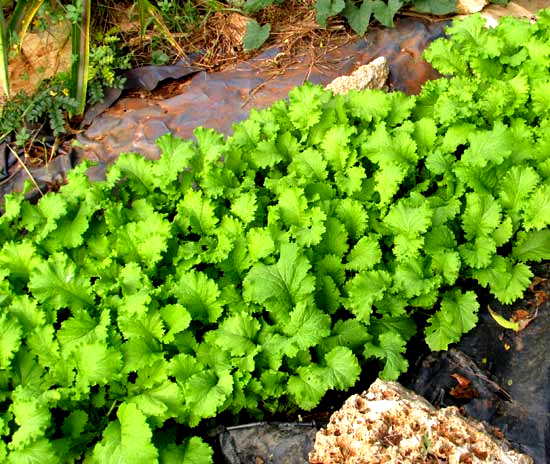
Nowadays, three months later and with the worst of the dry season's heat and dryness starting to bear down on us, my mustard greens still are producing much more than I can eat or give away. Despite the heat, the leaves aren't bitter. In fact, this is the best crop of mustard greens I've ever produced. Up north, my greens usually are attacked early on by tiny, black beetles that skeletonize the leaves. Here the native flora doesn't include members of the Mustard Family, so invertebrates didn't evolve to feed on that family, and I'm guessing that that's the reason for such success.
Some of my plants are beginning to flower. Below, you can see one of them photographed on an afternoon when the temperature was right at 100°F (38°C):
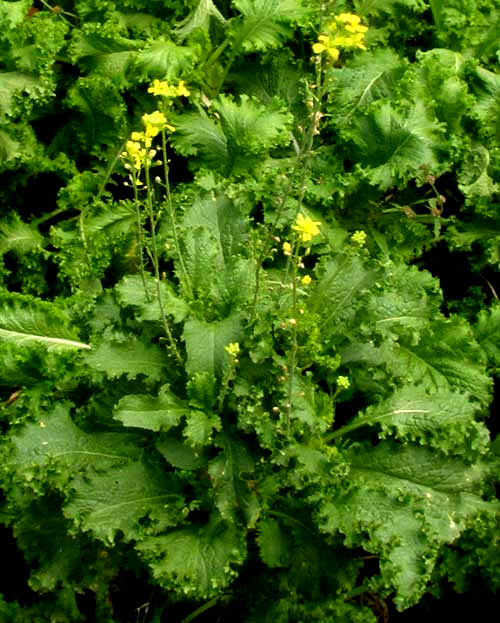
In that picture you can see the leaves' frilly margins, distinguishing this cultivar from numerous other kinds of "leaf mustards." The seed package from which these plants grew, purchased at a small ACE Hardware a year ago during my visit with family in rural western Kentucky, lists our cultivar as Southern Giant Mustard.
Leaf mustards are developed from the species BRASSICA JUNCEA, and my old Bailey's Manual of Cultivated Plants recognizes these varieties of that species: crispifolia, with cut, curled and crisped leaves (ours); foliosa, with large, wavy-margined leaves; longidens, with oblong leaves bearing narrow, forward-pointing lobes, and; multisecta, with leaves divided into threadlike lobes.
The genus Brassica is a big, very important one, embracing cabbage, kale, Brussels sprouts, cauliflower, rape or Canola, rutabaga, turnip, and the various edible-leaf mustards. It's a member of the Mustard Family, the Brassicaceae.
Our Southern Giant Mustards' flowers are classic Mustard Family blossoms, as seen below:
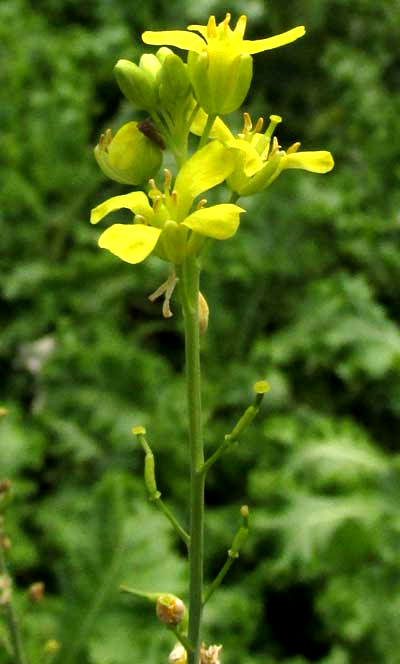
Up north at this time sometimes you see big springtime fields breathtakingly yellow with blossoms of various Mustard Family species, every flower with four petals standing opposite one another. Also, typical of the family is that once the flowers are pollinated and the petals have have fallen off, semi-succulent ovaries start enlarge below the newer flowers to form little fruit pods, each on its own slender stem, or pedicel. Below, other features of the Mustard Family are seen closer up:
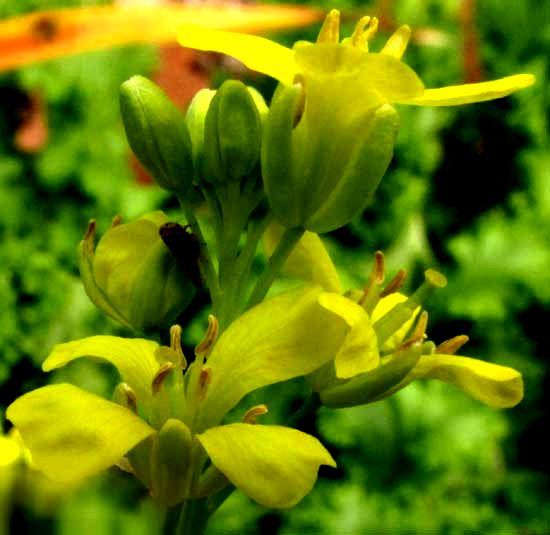
Here we see best in the lowest flower what's probably the most distinctive feature of Mustard Family blossoms: Each flower bears six stamens, of which two are shorter than the other four. The genus Brassica can be distinguished from other of the Mustard Family's 300 or so genera by features seen below:
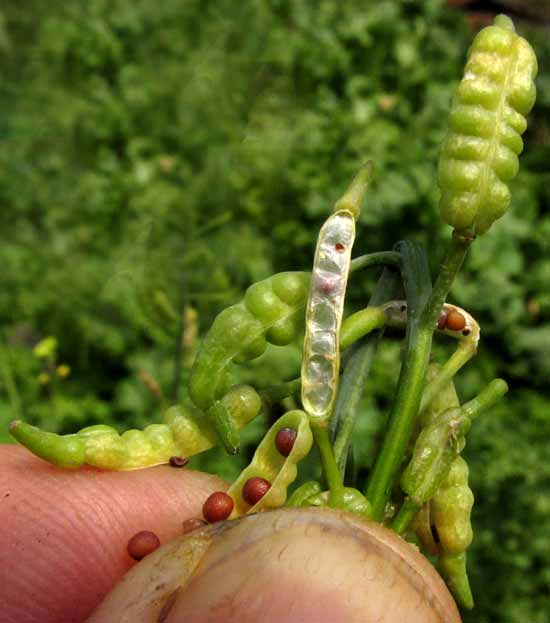
Notice that these fruit pods are tipped with thick, broad-based "beaks." The beak can be thought of as a thickened style, though in some species it may contain seeds. A slight constriction separates the beak from the pod's main body below, where seeds are produced. The seed-bearing part of the pod consists of two sides, or "valves," separated from one another by a silvery partition. Spherical, brown seeds are released when the valves separate. When more of my plants are in fruit, I'll collect the seeds for the next planting.
And there'll certainly be a next planting, especially after reading about the advantages of eating mustard greens. Here's something I found on the {now offline} Mustard Greens page of the AdamsHeirlooms.Com website:
"The cholesterol-lowering ability of steamed mustard greens is second only to steamed collard greens and steamed kale, in their ability to bind bile acids in the digestive tract."
Also, mustard greens contain two glucosinolates, sinigrin and gluconasturtiian, thought by some to offer protection against cancer. And they are an excellent source for vitamins K, A, C and E, as well as for manganese, calcium and dietary fiber. They're a very good source of potassium, vitamin E, vitamin B2 and magnesium, and a good source of vitamin B1 and vitamin B3 (niacin).
Mustard greens originated in the Himalayan region of India and have been grown for consumption for over 5000 years.